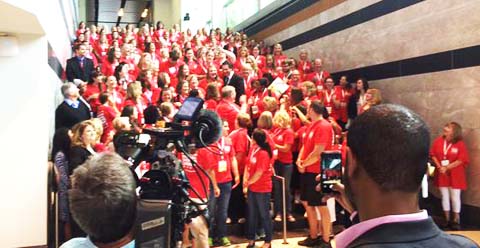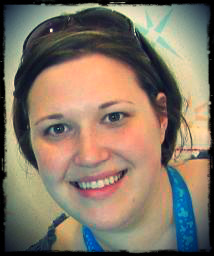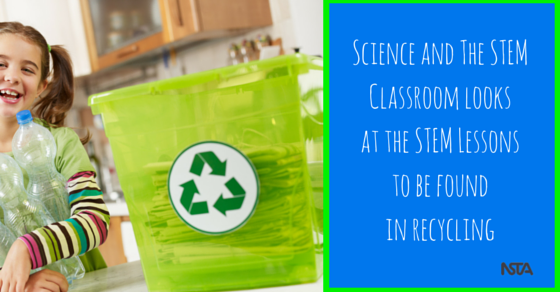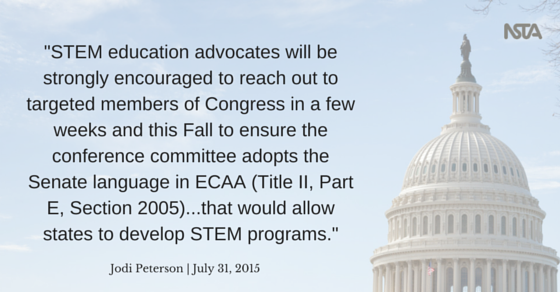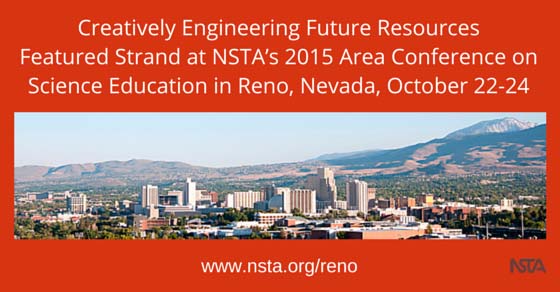SXSWedu 2016: Vote for NSTA’s Session Idea, The Next Generation of Science Teachers
By Guest Blogger
Posted on 2015-08-10
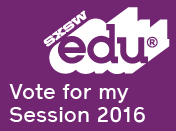 Voting opens today for SXSWedu session proposals for the conference’s 2016 program, and NSTA needs your vote! To be selected for inclusion at SXSWedu, proposals must pass an extremely competitive crowd-sourced PanelPicker process.
Voting opens today for SXSWedu session proposals for the conference’s 2016 program, and NSTA needs your vote! To be selected for inclusion at SXSWedu, proposals must pass an extremely competitive crowd-sourced PanelPicker process.
The 2016 event marks the sixth anniversary of this highly interactive conference, which converges education’s most energetic and innovative leaders from all backgrounds of the teaching and learning landscape—including teachers, administrators, professors, and business and policy stakeholders—to discuss a number of key topics in education. We want to represent science teachers at the event and, to talk about the role that the next generation of science teachers will play in this fast-changing world.
What can you do to help? Please vote for our session proposal. Why does it work this way? SXSWedu crowd sources sessions to be sure the public has a chance to weigh in on the topics they’d most like to see covered. Public voting, in addition to the comments from the SXSWedu Advisory Board and staff, help to form the 2016 event.
Please help give science educators a voice in the discussion at SXSWedu by casting a vote for NSTA’s session, The Next Generation of Science Teachers. Public voting opens today, August 10, and closes September 4, so check out our session proposal now and cast your vote!
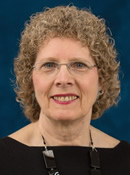 Carolyn Hayes is the NSTA President, 2015-2016; follow her on Twitter at caahayes.
Carolyn Hayes is the NSTA President, 2015-2016; follow her on Twitter at caahayes.
The mission of NSTA is to promote excellence and innovation in science teaching and learning for all.
Follow NSTA
 Voting opens today for SXSWedu session proposals for the conference’s 2016 program, and NSTA needs your vote! To be selected for inclusion at SXSWedu, proposals must pass an extremely competitive crowd-sourced PanelPicker process.
Voting opens today for SXSWedu session proposals for the conference’s 2016 program, and NSTA needs your vote! To be selected for inclusion at SXSWedu, proposals must pass an extremely competitive crowd-sourced PanelPicker process.
Transforming Teaching at the 2015 Mickelson ExxonMobil Teachers Academy
By Guest Blogger
Posted on 2015-08-10
What happens when you bring together 150 third- through fifth-grade teachers from around the country for a week of the highest quality professional development around STEM? I found out last week at the 2015 Mickelson ExxonMobil Teachers Academy (MEMTA) in Jersey City, where a major shift in mindset rippled out across all 50 states, expanding like the “Cubes that Grow.” A force was set in motion with the power to transform lives; as teachers, we were asked to teach our students not “what to think” but “how to think.”
The Right Kind of Struggle
At MEMTA, the National Science Teachers Association (NSTA) prepared five full days of lessons to help teachers build knowledge in specific content areas while experiencing and analyzing the best practices in teaching the multi-dimensional Next Generation Science Standards (NGSS). Sprinkled throughout the week were inspirational talks by leading thinkers on the subject of how children learn. We began the week with Cathy Seeley, author of Faster Isn’t Smarter and Smarter Than We Think, who spoke about “The Right Kind of Struggle”–creating opportunities for students to work through challenging problems that can increase intelligence. As the week continued, we heard from Sam Shaw and NASA astronaut Leland Melvin; and on Thursday, we spent the afternoon with numerous ExxonMobil engineers.
Each MEMTA class/session is focused around a guiding question. This year the theme was Force and Motion, and as the week progressed we actively explored Newton’s laws while simultaneously considering best practices for engaging students. Strategies were devised for setting up guided explorations and creating a classroom culture in which explanations based on claims and evidence can arise. Practices help students see themselves as scientific thinkers and develop habits of mind and the confidence to pursue a STEM career.
Nurturing Scientific Thinking
As teachers gained confidence and experience throughout the week I heard repeatedly, “it is too bad I have only twenty minutes a day to teach science, art, and social studies.” It is true, the time constraints placed on most public school teachers can seem very restrictive, but there is a way to optimize the impact of teacher-structured classrooms, even on a tight schedule. The scientific approach to problem solving can be applied to other disciplines in the classroom. Teachers can embrace Rodger Bybee’s BSCS 5E Instructional Model and infuse the entire school day with meaningful engagement, rich exploration, and opportunities to learn from each other, with time allowed for purposeful idea sharing. They can encourage students to elaborate and foster an expectation that we will be reflective as we evaluate across the curriculum and throughout the day, so all of our students will grow and develop the thinking skills required to solve today’s problems and future challenges. The scientific mind is not something that turns off at the end of science class.
During the week at MEMTA we worked with the 5E model during both science and math activities. As we return to our schools we can also create language arts, social studies, and art classes that engage students in the same way. So, as we switch from teacher-centered classrooms to teacher-structured classrooms we can move forward with six hours of science-based thinking and claims based reasoning. We can take our experience in Jersey City and pay it forward. We no longer need to feel constrained by a limit of twenty minutes a day to teach science. We can infuse every minute of every school day with opportunities for students to engage, explore, explain, elaborate and evaluate. Developing the habits of mind to think like a scientist can and should move across the curriculum. Teachers can learn to talk less and to listen more.
Learn more about MEMTA and how 3rd- through 5th-grade teachers can apply for next year’s academy at sendmyteacher.com.
Author Eileen Hynes is a 2015 MEMTA participant from the Lake and Park School in Seattle, WA; she can be reached at eileen@lakeandparkschool.org.
The mission of NSTA is to promote excellence and innovation in science teaching and learning for all.
Follow NSTA
Interactive science notebooks
By Mary Bigelow
Posted on 2015-08-05
Teachers often have questions about interactive science notebooks, especially at the secondary level. Mary Morgan, a high school science teacher from Belton High School in Belton, Texas, shares her experiences (These ideas refer to traditional formats. Ms Morgan will share her thoughts on electronic notebooks in a future blog.)
Ms. Mentor: How are interactive science notebooks different from the traditional idea of notebooks as a collection of handouts, lab reports, and notes copied from the board and organized in a way determined by the teacher?
Ms. Morgan: The “interactivity” of interactive notebooks comes from the fact that students are working with the information in various ways as they fill in the notebook. Usually this starts with taking Cornell notes on a topic on the right side, whether during a direct teach session, from a video or the textbook, or during a web-quest. Then the students use the left side of the notebook to process the information from the notes. Working with, and often times, struggling with, the new information is a crucial piece for learning. The processing leads students to take ownership of the information. The processing methods vary, but processing always require the students to interact with the new information in some form leading to understanding and owning the information.
Ms. Mentor: Are interactive notebooks appropriate for high school? How do students respond to them?
Ms. Morgan: I have used INBs (Interactive Notebooks) for the last eight of the nine years I’ve been teaching. I have used them for inclusion (low level learners), on-level, and pre-AP Biology; on-level and Honors Anatomy; and physiology; zoology; and AP Biology. My students complain at first every year, but by the time the end-of-course (EOC) exams roll around in May, they thank me for doing the notebooks because they are organized and easy to study!
Ms. Mentor: Do you get any feedback from parents?
 Ms. Morgan: The feedback from parents is usually similar to students at first. They usually have some trepidation as this is new for many parents as well. Some will ask why we are doing a middle school notebook or how we are covering all the information in a small space. Some parents also have concerns about how we grade the notebook. However, once I sit with the parents in a one-on-one conference, show them completed notebooks from prior years, explain how the notebook organizes the information and helps students study for unit tests, and creates an EOC review guide throughout the year, most parents are on-board with the INBs. By the end of the year, the parents I speak with comment about how great the INBs are and they wish other teachers would do them as well. I am planning a parent/guardian/trusted adult check-off sheet to encourage parents and guardians to be more hands on with their students’ work and study habits.
Ms. Morgan: The feedback from parents is usually similar to students at first. They usually have some trepidation as this is new for many parents as well. Some will ask why we are doing a middle school notebook or how we are covering all the information in a small space. Some parents also have concerns about how we grade the notebook. However, once I sit with the parents in a one-on-one conference, show them completed notebooks from prior years, explain how the notebook organizes the information and helps students study for unit tests, and creates an EOC review guide throughout the year, most parents are on-board with the INBs. By the end of the year, the parents I speak with comment about how great the INBs are and they wish other teachers would do them as well. I am planning a parent/guardian/trusted adult check-off sheet to encourage parents and guardians to be more hands on with their students’ work and study habits.
Ms. Mentor: Teachers have different ideas about the format of the notebook: composition books, spiral books, binders, pocket folders. Is there a “best” format to use?
Ms. Morgan: I use composition notebooks. They are a little pricier than spirals, but they hold together all year long and the pages being harder to remove. I make it quite clear to the students that no pages are to be ripped out ever! (I offer notebook paper to those who need it if someone at home is tempted to tear a page out. This has been an issue with some students in the past.) For students who can’t afford a notebook, I will quietly give them one I purchased.
Ms. Mentor: It seems that student ownership in the document would be essential. What opportunities do you provide for student input?
 Ms. Morgan: I use a combination of personalization and consistent formatting. I have my students decorate the front of their notebooks using old magazine photos. (I tell them anything I deem inappropriate will be ripped off, so that usually solves that problem.) I encourage them to use a mix of science pictures and personal likes. We cover the fronts with clear contact paper. I then apply colored duct tape to the spine which helps the notebooks hold together better all year long and allows me to color code notebooks by class period.
Ms. Morgan: I use a combination of personalization and consistent formatting. I have my students decorate the front of their notebooks using old magazine photos. (I tell them anything I deem inappropriate will be ripped off, so that usually solves that problem.) I encourage them to use a mix of science pictures and personal likes. We cover the fronts with clear contact paper. I then apply colored duct tape to the spine which helps the notebooks hold together better all year long and allows me to color code notebooks by class period.
 I have students create a title page and a table of contents, and they number ALL of the pages. They also put an envelope in the inside back cover of each notebook to keep loose items (e.g., vocabulary cards, model pieces, cut-outs that haven’t been used yet). We also use colored masking tape to make tabs for each unit so students can quickly flip back and forth between old and new work. We also include flip-outs on the front and back covers which contain reference materials. These pages can be flipped out from the cover and viewed from any page in the notebook.
I have students create a title page and a table of contents, and they number ALL of the pages. They also put an envelope in the inside back cover of each notebook to keep loose items (e.g., vocabulary cards, model pieces, cut-outs that haven’t been used yet). We also use colored masking tape to make tabs for each unit so students can quickly flip back and forth between old and new work. We also include flip-outs on the front and back covers which contain reference materials. These pages can be flipped out from the cover and viewed from any page in the notebook.
At the beginning of the school year, I show students tips and tricks for organizing the notebooks, but eventually most students develop their own organizing style for their notebook which is one type of ownership.
Ms. Mentor: The color coding is something I can appreciate, especially when I taught six sections! And the personalized cover would help students identify their notebook quickly. How do you handle having students add papers to the notebooks?
Ms. Morgan: I keep a supply bucket on each table with markers, tape, scissors, short rulers, and a separate bin for trash. I use dotted lines on everything to reduce cutting time, and we use mostly cellophane tape to put things in the notebook (Rarely we will glue with liquid glue, and we never use staples, glue sticks, or chewing gum!) All trash goes in the bin at the end of class; one of my table jobs is that “Number Ones” take out the trash.
Ms. Mentor: Getting to the “interactive part,” how do students organize their work during the class period?
 Ms. Morgan: I have done the notebooks multiple ways, but I now have settled into the AVID set-up for the right and left pages. Based on the AVID structure, right pages are teacher input/direct teaching pages: Cornell notes, teacher demos, Fold
Ms. Morgan: I have done the notebooks multiple ways, but I now have settled into the AVID set-up for the right and left pages. Based on the AVID structure, right pages are teacher input/direct teaching pages: Cornell notes, teacher demos, Fold
ables (used as notes), the driving question, hypothesis, and lab data . Right pages have odd numbers on them for page numbers, so I tell the students they are my pages because I’m odd. Student output goes on the left, evenly numbered pages. This is a place for the student to process the right page information with pictures, colors, writing, etc. Some students will create a Foldable with the right-page information so that would go on the left side. Analysis (graphs, tables, statistics) and conclusions/reasoning go on this page for labs. If students do one-pagers for review, that would go on the left side.
Ms. Mentor: Do you evaluate the student notebooks? That could be an overwhelming task.
Ms. Morgan: It took me a while to come up with a system. Whatever you do, don’t try to grade them all at once! You’ll be at school for hours and hours. I like to grade one or two pages on test days and can usually get through a class’s notebooks during the period. I also do short checks during class (warm-up time, independent work time) and have students provide feedback to each other on their notebooks.
Having students do peer feedback requires them to understand and critically think about the information being presented and teaches them how to assess work and documents without bias. I’ve also seen students self-assess after going through the peer review process a few times and so they begin to create better work from the start. I have to teach my students how this process works and monitor them, especially the first few times, to ensure that constructive criticism does not become simply criticism. I have found that oftentimes they are harder on each other and themselves than I am.
Ms. Mentor: Do you have any other suggestions for someone just starting with interactive notebooks?
 Ms. Morgan: Do what works for you. Try something and if it doesn’t work after a couple of times, change it. Develop you own notebook vocabulary and your students will catch on. If you need every student on the same page, do it. If you are okay with students being on their own page, do it. For example, all of my students have to be on the page I tell them and I keep a class-wide table of contents on a big poster sheet of notebook paper. But don’t be bound by what works for someone else. Make the notebook work for your teaching style.
Ms. Morgan: Do what works for you. Try something and if it doesn’t work after a couple of times, change it. Develop you own notebook vocabulary and your students will catch on. If you need every student on the same page, do it. If you are okay with students being on their own page, do it. For example, all of my students have to be on the page I tell them and I keep a class-wide table of contents on a big poster sheet of notebook paper. But don’t be bound by what works for someone else. Make the notebook work for your teaching style.
Anything you have done using other formats can [be adapted] to the notebook. For example, Foldables fit great in the notebook. Sometimes it requires a little different fold or a bit of extra trimming, but you can make it work. Old worksheets/notes can work by reducing the size on your copy machine and adding a dotted border for trimming. I also copy lots of things on half-pages because those fit great in the notebooks. I make notebook pages into pockets for brochures and other handouts. The sky is the limit with the notebooks!
Ms Mentor: I’ve put together a Resource Collection in the NSTA Learning Center on the topic of “Science Notebooks” with articles and websites that may be helpful.
Teachers often have questions about interactive science notebooks, especially at the secondary level. Mary Morgan, a high school science teacher from Belton High School in Belton, Texas, shares her experiences (These ideas refer to traditional formats. Ms Morgan will share her thoughts on electronic notebooks in a future blog.)
Recycling in the STEM Classroom
By Becky Stewart
Posted on 2015-08-04
Our oldest son will be a senior in high school next year. (Deep breath.) All Delaware public high school students must perform 60 hours of documented volunteer work for a non-profit group as a requirement for graduation. With a little nudging from me, our son chose Habitat for Humanity. New Castle County’s Habitat chapter runs a ReStore, where homeowners and contractors donate new or gently used home parts, like windows, flooring, sinks, tile, and furniture. The donated items are sold at very reasonable prices to other members of the community for use in their homes. The boy has found his niche, and wants to keep volunteering there as long as he can. They’re happy to have him, since he’s built like a lumberjack and can carry like one too. Having a way to keep cabinets, doors, and windows out of landfills is a great help to the environment and got me thinking about the many STEM elements in recycling programs of all kinds. This month we’ll take a tour around the world, and dip into geology, hydrology, technology, environmental science, chemistry, economics, global politics, and ethics.
Bottled water
Yes, bottled water has borne the brunt of criticism from environmentalists for years. If you don’t have a refillable aluminum, glass, or plastic jug on your desk by now, you’re doing it wrong. We all know how much energy it takes to make those ubiquitous thin plastic, half-liter bottles. (Approximately 3 to 5 million joules each, to be specific.) Beyond the cost of plastic production are the added factors of transportation, distribution and refrigeration at the point of sale. Bottled spring water comes from sources all over the world, including Fiji and the Alps. Getting that water to your refrigerator adds significantly to its costs.
In addition to the environmental impact of bottled water consumption, another issue is economic. Did you know that almost 55% of bottled water is glorified tap water, not spring water? It’s almost the same thing you can get from your own faucet at any time. What’s worse, is that a number of large bottled water companies are located in California, which is experiencing record drought conditions. Water privatization is an issue that should concern everyone. Approximately 10% of the world’s water is currently under private control and this percentage is expected to grow as municipalities look for ways to reduce the cost of maintaining aging infrastructure. Privatization removes this cost from the government’s balance sheet, but puts the water supply under the control of a corporation, which has the sole aim of making money for its shareholders. When more than 1 billion people in the world lack access to safe drinking water, this seems short sighted at best.
Tap water in the United States has an average cost of US$2 per 1000 gallons. When you consider that the average wholesale cost of bottled water in the United States is US$1.21 per gallon, you can see that choosing a bottle over a glass in your own kitchen makes very little sense. If the taste of your home’s water bothers you, consider buying a filter for the tap or a pitcher with a built-in filter. You’ll come out ahead on cost, and the environment will benefit too. The current recycling rate for water bottles is about 39%. The rest of the bottles end up in landfills or as trash in the environment. The water bottle industry has worked to reduce the amount of plastic in its bottles as a nod to environmental responsibility, but these measures have also reduced their costs.
Rare earth elements
A number of modern technologies depend on the 17 rare earth elements. The vast majority of rare earth element production is currently in China. China possesses approximately 50% of global rare earth element reserves. Because China has relatively large quantities of these elements while also having the advantages of lax environmental controls and cheap labor, it dominates the market. Rare earth elements became an issue of national security in 2010 when China allegedly placed an embargo on exports of these materials to Japan in response to an offshore border dispute. Japan is the largest market for rare earth elements, as much of the consumer products that use them are made there.
Many of the products that depend on rare earth elements are recent inventions. Some of the most well-known products are cell phones, solar cells, electric cars, and wind turbines. Rare earth elements became necessary in the mid-1960s when color televisions needed brighter red pixels. A particular valency state of europium produces red light by phosphorescence. This also makes europium useful in compact fluorescent light bulbs.
Perhaps the most important use of rare earth elements is in permanent magnets. Permanent magnets do not become nonmagnetic once the magnetic field is removed. These permanent rare earth magnets are very powerful and some can retain their magnetic properties at high temperatures, making them invaluable to industries like aerospace and defense, health care, clean energy and electronics. If you’ve ever undergone magnetic resonance imaging (MRI), you’ve had the warning about wearing clothes without metal fasteners. The magnets are so powerful that they can pull on any iron-containing object in the body. On occasion, this attraction can cause the iron-oxide pigment in tattoos to heat up and cause first-degree burns. (To be honest, I thought this was a myth and I’m quite surprised. The things you learn!) Please note that this effect is rare and no good reason to skip an MRI.
One of the biggest problems with rare earth element mining and refining is the waste products. A principal byproduct of rare earth element production is radioactive thorium. A number of the other waste products from rare earth mining are similarly toxic. Baotou, in Inner Mongolia, China, is widely contaminated with these toxic waste products. Two-thirds of the 97% of rare earth elements that come out of China are produced in Baotou. China’s market dominance allows the government of China to dictate the price of rare earth materials, but this economic power has come at a price. The ground in Baotou is saturated with toxic waste, and a huge tailings pond dominates the landscape. The farmers have moved away. The factory workers that remain experience various health issues.
These environmental concerns and supply issues have led to important research on rare earth element recycling. Current recycling methods are expensive and have their own undesirable byproducts. But innovative research in Japan uses salmon sperm to recover rare earth elements in an aqueous process that is more environmentally friendly. Because of the particular market constraints on these vital elements, it’s important to develop a viable recycling method.
Recycling in the future
The United States has made significant improvements in recycling rates in the last 20 years. But the overall recycling rate in the United States is still less than 40%. There is no federal recycling legislation in the United States, but 47 of the 50 states have disposal bans to keep at least some items out of landfills. Recycling has also increased in importance globally. It may surprise you to know that about 70% of the world’s electronics wastes are exported to China. Recycled materials supply 40% of the world’s raw material needs, but the energy and CO2 savings vary by material. Austria has the best overall recycling rate, recovering 60% of total recyclable materials. Brazil has the next best rate, at 50% of all waste. Greece has the lowest overall recycling rate, at 10%.
Aluminum (or aluminium, depending on where you learned to spell) is one of the most common recycled materials. More than a third of global aluminum production today comes from recycled materials. This is important because recycled aluminum uses as little as 5% of the energy and emits only 5% of the greenhouse gases of primary aluminum production.
Glass is another common recycling target. Glass can be recycled forever. Recycling a glass jar saves energy because recycled glass melts at a lower temperature than the original components. Switzerland recycles 91% of all manufactured glass. This is currently the best recycling rate for a single commodity.
Recycling is becoming a high-tech industry. RFID tags on household recycling bins and the collection trucks can provide information about neighborhood participation rates, allowing cities to tailor incentive programs to low participation areas. RFID tags on the regular waste bins paired with scales on the collection trucks would also let municipalities accurately charge households for the cost of waste disposal. Most bottled water is consumed on the go, so strategic placement of recycling bins in dense urban areas could increase participation rates. Another area of technology with important future implications is solid waste gasification for energy recovery. Currently only 2% of the energy in solid waste is recovered.
Produced by the National Science Teachers Association (NSTA), science writer Becky Stewart contributes monthly to the Science and STEM Classroom e-newsletter, a forum for ideas and resources that middle and high school teachers need to support science, technology, engineering, and math curricula. If you enjoy these blog posts, follow Becky Stewart on Twitter (@ramenbecky). Fans of the old version of The STEM Classroom e-newsletter can find the archives here.
Follow NSTA
What's the Role of Science Teachers in the New Conceptual Economy?
By Lauren Jonas, NSTA Assistant Executive Director
Posted on 2015-07-31
In the new conceptual economy, what skills will students need to acquire to walk into professional settings and tackle complex problems? A recent podcast Innovation Skills for the 21st Century Workplace (BFM 89.9) details the mindset that contributes to success–the ability to continually learn and improve. And it’s striking how well the skills and qualities needed align with the types of skills and qualities that can be honed in a science classroom–communication, collaboration, and adaptability, among others.
Creatively Teach Creativity
What can science teachers do? Science evangelist Ainissa Ramirez writes frequently about these types of skills. In a recent blog, Ramirez talks about Encouraging the Einstein and Edison in Everyone. And she gives simple, inexpensive ideas that any teacher can use. She explains how to nurture divergent thinking within students with an ordinary object like a key or a toothbrush. And, she recommends helping students learn to make connections among formerly unconnected topics. The takeaway? “Let’s be creative in the way that we teach children to be creative.”
Cultivate Collaboration
In Building Team Science, education professor Christine Royce gives ideas for team-building activities that have found their way into her classroom activities throughout the years:
Innovation in Action
So what does a classroom look like when innovative thinking is nurtured? Check out NSTA’s video series In the NGSS Classroom with Teacher Kristin Mayer. These 8 videos introduce science teachers to important strategies based on the Framework for K-12 Science Education and the Next Generation Science Standards (NGSS). The videos highlight the major shifts in science instruction, explore the new role of the teacher, and demonstrate new instructional strategies in the high school classroom.
At NSTA we’re lucky to work with and learn from innovative teachers every day. If you’ve got ideas to share with us, please let us know!
The mission of NSTA is to promote excellence and innovation in science teaching and learning for all.
Upcoming NSTA Conferences
2015 Area Conferences
2016 National Conference
2016 STEM Forum & Expo
Follow NSTA
In the new conceptual economy, what skills will students need to acquire to walk into professional settings and tackle complex problems? A recent podcast Innovation Skills for the 21st Century Workplace (BFM 89.9) details the mindset that contributes to success–the ability to continually learn and improve.
Legislative Update
House and Senate Leaders Begin Work to Reconcile Education Bills to Replace No Child Left Behind
By Jodi Peterson
Posted on 2015-07-31
Work has officially begun on the conference bill to resolve the differences in the House (H.R. 5, the Student Success Act) and Senate (S. 1177, the Every Child Achieves Act of 2015) bills to reauthorize the Elementary and Secondary Education Act and replace No Child Left Behind.
In a press statement issued on Thursday, July 30, the four education leaders in the House and Senate [House Education and the Workforce Committee Chairman John Kline (R-MN); Ranking Member Bobby Scott (D-VA); Senate Health, Education, Labor, and Pensions Committee Chairman Lamar Alexander (R-TN); and Senate Ranking Member Patty Murray (D-WA);] issued statements which expressed confidence and expressed hope that they can work together to produce a bicameral education bill.
As noted in an earlier NSTA Legislative blog post, on July 16 the U.S. Senate passed legislation to rewrite the No Child Left Behind Act. The bipartisan Senate bill, the Every Child Achieves Act (S.1177) passed 81-17 and contains a strong focus on STEM education. The partisan House bill, the Student Success Act (H.R. 5), passed on July 8, with 27 Republicans joining all House Democrats voting against the bill. The House bill goes much further than the Senate bill in reducing the federal role in education and does not include a dedicated program for STEM education.
Below are the key STEM provision in the Senate bill and other highlights from the House and Senate education bills. Congress adjourns at the end of July until after the Labor Day break (but education staff will continue to move the conference process along) so STEM education advocates will be strongly encouraged to reach out to targeted members of Congress in a few weeks and this Fall to ensure the conference committee adopts the Senate language in ECAA (Title II, Part E, Section 2005) listed below that would allow states to develop STEM programs.
Every Child Achieves Act (S. 1177) STEM Funding Provision (Title II, Part E, Section 2005)
Section 2005, which was added in a bipartisan Franken-Kirk Amendment during Committee consideration, establishes a program to provide each state with formula-based funding that would be used to support partnerships among local schools, businesses, universities, and non-profit organizations to improve student learning in the critical science, technology, engineering, and mathematics (STEM) subjects. Each state would choose how to spend and prioritize these funds, which can support a wide range of STEM activities from in-depth teacher training, to engineering design competitions, to improving the diversity of the STEM workforce. Activities supported through these funds include:
- Professional development for STEM educators
- Improving access and quality for STEM programs targeting high-need and underrepresented student populations
- Integrating in-school and out-of-school STEM education activities
- Supporting STEM-related competitions
- Facilitating the involvement of mid-career STEM professionals in educational activities
- Recruiting, retaining, and rewarding outstanding STEM educators through state-level STEM Master Teacher Corps programs
A funding level has not yet been established for this provision and is currently “such sums as required.” The funding authorization level for the current Math and Science Partnerships program at the Department of Education, which this provision would replace, is $450 million per year; however the appropriations for this program in FY2015 is $155 million.
Here are some other key highlights from the House and Senate passed education bills:
Testing and Standards: Both bills maintain current-law requirements for annual, statewide assessment of all students in grades 3–8 and at least once in high school, in both reading and math, as well as the requirement of a science assessment of all students in science at least once during elementary, middle, and high school. The bills also maintain the requirement that states adopt college- and career-ready standards in these subjects.
Accountability: Both bills eliminate NCLB’s adequate yearly progress requirements and require states to create their own accountability systems that annually measure student performance. The Senate bill goes further to require that state accountability systems include more than just test scores and also requires that states report how they assess school climate, discipline, homeless children, and early education. The House bill moves in the other direction and provides states with the option of not counting students that “opt-out” of federal testing against measures of test participation.
STEM Education: The Senate bill contains a program (Section 2005; see above) that would provide each state with dedicated funding to support improvements in the STEM subjects, with a strong focus on improving access and quality for high-need student populations. The House bill does not place any priority on STEM-related activities or provide any form of dedicated funding for STEM activities.
Support for Teachers and Teacher Quality: Both the House and Senate bills provide states with significant new flexibility in using Title II funds for teachers and school leaders. Both bills allow states to use federal funding to develop teacher evaluation systems, but it’s not a requirement. And the bills eliminate the definition of “highly qualified teacher” and instead let states decide what constitutes teacher quality.
Low-Performing Schools: Both bills eliminate the School Improvement Grant program, but include other federal funding directed at low-performing schools. Under the House bill, states would set aside 7% of their own Title I money for school improvement. States would have to intervene in Title I schools that aren’t performing well, but the bill doesn’t tell them how to do so, or how many schools to try to fix at a time. Under the Senate bill, states would have to monitor district turnarounds, and step in if low-performing schools weren’t getting any better. However, the federal government would be prohibited from telling states or districts how to fix struggling schools.
Jodi Peterson is Assistant Executive Director of Legislative Affairs for the National Science Teachers Association (NSTA) and Chair of the STEM Education Coalition. e-mail Jodi at jpeterson@nsta.org; follow her on Twitter at @stemedadvocate.
The mission of NSTA is to promote excellence and innovation in science teaching and learning for all.
Follow NSTA
Building Team Science
By Christine Royce
Posted on 2015-07-29
 Team building is something that any sports team undertakes; business teams participate in; as well as other professional areas focus on. The purpose of team building is to bring individuals together to develop interactions that enhance or increase the effectiveness of the team. So yes – it is important to develop and build skills in students that will help them be successful in Team Science situations.
Team building is something that any sports team undertakes; business teams participate in; as well as other professional areas focus on. The purpose of team building is to bring individuals together to develop interactions that enhance or increase the effectiveness of the team. So yes – it is important to develop and build skills in students that will help them be successful in Team Science situations.
The recently released report Enhancing the Effectiveness of Team Science focuses on how the pursuit of scientific endeavors has become “team science.” According to the report, team science is defined as “scientific collaboration, i.e., research conducted by more than one individual in an interdependent fashion, including research conducted by small teams and larger groups.” The reason for this team science approach is that scientific research is increasingly conducted by small teams and larger groups rather than individual investigators. However there are some drawbacks to this approach as well which include the challenges of collaboration which can slow these teams’ progress in achieving their scientific goals. How well a team works together is viewed as “team effectiveness (also referred to as team performance) [which is] [a] team’s capacity to achieve its goals and objectives. This capacity to achieve goals and objectives leads to improved outcomes for the team members (e.g., team member satisfaction and willingness to remain together), as well as outcomes produced or influenced by the team. In a science team or larger group, the outcomes include new research findings or methods and may also include translational applications of the research.”
In considering the these definitions, the idea of creating an environment that generates communication, collaboration, promotes creativity and innovation, as well as using critical thinking and problem solving skills is exactly what the college and career ready reports have been requesting for many years. In a second report titled Preparing 21st Century Students for A Global Society: An Educator’s Guide to the Four Cs there is a discussion of the importance for helping students become skilled in these 21st century skills that are needed in all aspects of our global world.
While solid science instruction is necessary to build student’s understanding of science, there is still a need to develop these other skills which often is not part of the actual curriculum. Therefore, a disclaimer – I am not sure where these activities would fit into your curriculum as they do not meet a national or state standard most likely. Furthermore, time is short and working together is something that one would think most students should learn early on in life. With that stated, the following are a few activities that have been used in various professional development activities attended that have found their way into classroom activities throughout the years.
Colored Broken Squares – A non-verbal problem solving activity that requires collaboration and cooperation as well as attention to detail.
Write It Do It – An older activity from the Science Olympiad that asks students to practice their writing skills in describing a structure and then switch with a partner who must follow the directions.
Tower of Cups – A problem solving activity that requires critical thinking and communication among team members.
Yes/No Conundrums – Requires students to ask yes/no questions to solve a riddle that is presented. Sometimes these are referred to by a commercial name as Stories with Holes.
These are but a few of the strategies that have found their way into my classroom regardless of the level over the years. Since helping students master the four Cs places them in a better position for the future, it is important to find the time to allow them time to develop communication, collaboration, critical thinking and problem solving and creativity and innovation. What activities or approaches can you add to the list as we collaborate together?
 Team building is something that any sports team undertakes; business teams participate in; as well as other professional areas focus on. The purpose of team building is to bring individuals together to develop interactions that enhance or increase the effectiveness of the team. So yes – it is important to develop and build skills in students that will help them be successful in Team Science situations.
Team building is something that any sports team undertakes; business teams participate in; as well as other professional areas focus on. The purpose of team building is to bring individuals together to develop interactions that enhance or increase the effectiveness of the team. So yes – it is important to develop and build skills in students that will help them be successful in Team Science situations.
Creatively Engineering Future Resources: Featured Strand at #NSTA 2015 Area Conference on Science Education in Reno, Nevada, October 22-24
By Lauren Jonas, NSTA Assistant Executive Director
Posted on 2015-07-28
Pose for a groupie shot with your science teacher friends this fall and you just may find the inventor of the “camera on a chip” in the photo! Cell phone camera inventor and Dartmouth Engineering Professor Eric Fossum will be the featured speaker for a special strand “Creatively Engineering Future Resources” at the NSTA 2015 Area Conference on Science Education, in Reno, October 22-24.
The featured presentation for this strand will be “Saturn to Smartphone Cameras: A Story of Science and Technology Innovation, on Thursday, October 22 3:30 PM – 4:30 PM, in the Reno-Sparks Convention Center, C1. Fossum will discuss the story of his invention of the CMOS image sensor and how that technology went from a NASA laboratory, through an entrepreneurial startup company, and into your smartphone. The critical role of science education in public schools and through supplemental programs will be highlighted.
What else will you learn about creatively engineering future resources? Below is a small sampling of other sessions on this topic:
- Using Project Based Learning to Teach Climate Change
- Healthy Land, Healthy Us! Informal/Formal Education Partnership
- Put the “E” in STEM!
- Recycled Goods as Inspiration in Learning: The Secret Life of Everyday Things
- Making a Better City
Want more? Check out more sessions and other events with the Reno Session Browser/Personal Scheduler. Follow all our conference tweets using #NSTA15, and if you tweet, please feel free to tag us @NSTA so we see it!
The mission of NSTA is to promote excellence and innovation in science teaching and learning for all.
Future NSTA Conferences
2015 Area Conferences
2016 National Conference
2016 STEM Forum & Expo
Follow NSTA
NSTA summer journals for K-12 teachers
By Mary Bigelow
Posted on 2015-07-26
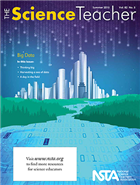 Add these journals to your summer reading!
Add these journals to your summer reading!
The Science Teacher: Big Data
As the editor says this month, “Scientific progress doesn’t result from simply accumulating data.” And data is definitely accumulating rapidly! Analyzing and interpreting data is one of the NGSS science and engineering practices, and how to organize, analyze, and interpret data (from students’ own investigations or from the work of others) and how to recognize valid conclusions from data are important if our students are to be informed citizens and potential scientists. (Career of the Month: Data Analyst).
It’s easy to find articles or news sites that summarize data and present an interpretation, but the editor continues: “…students can engage in the higher-order thinking involved in analyzing and interpreting large science datasets (big data) and designing their own inquiries to discover patterns and meaning in mountains of accessible data.” These data are collected by probes and investigators and are often streamed in real time. The featured articles in this edition focus on classroom strategies for investigations using secondary data.
- Thinking Big: Most students have had experience in data in their own investigations. But students and teachers also have access to large data sets via the Internet, from research projects and citizen science databases. The authors discuss the differences between local and large-scale data sets and how to transition to using “big” data in the classroom. The article has examples of strategies (provided in the Connections), a list of K-12 projects that provide big data, and suggestions for classroom projects.
One of the suggested projects that I am familiar with is NOAA’s Data in the Classroom. Each module has five levels of lessons ranging from teacher-presented ones to letting students explore the data to full-blown problem solving and invention. Each module shows the associated data in a variety of formats and guides the users through how to interpret it. There are “checkup” questions throughout, and teachers can download the materials.
- A Day in the Field introduces the term “secondary data”–data collected by others. Students studied a local estuarine system and shared their data with those collecting similar data at other locations. It was an authentic experience in using analysis tools such as mapping and spreadsheets. As the authors noted “Data analysis is about pattern recognition.”
- Harvesting a Sea of Data describes how students can study migration patterns using data from the Ocean Tracks research program. The project provides opportunities for students to study phenomena in faraway locations. (see also the Oceans of Data website)
[For more on the content that provides a context for these projects and strategies see the SciLinks websites for Birds, Telesccopes, Watersheds, Estuaries, Migration]
Continue for Science Scope and Science and Children.
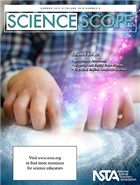 Science Scope: Science for All
Science Scope: Science for All
Strategies that help students with learning disabilities, students who are English Language Learners, or students with physical impairments have the added benefit of being appropriate for others. This was also the theme for the April issue of The Science Teacher, so we have a lot of resources on this topic in addition to these featured articles!
- Touching the Stars: Making Astronomy Accessible for Students With Visual Impairments addresses the question of how to help all students with subjects that rely heavily on visual information. The Skynet Junior Scholars online program includes online access to telescopes and data, a student-friendly interface to control telescopes, and instructional modules. The technology also can convert digital images to tactile models. The araticle includes a table of resources for accessible materials.
- The authors of Engineering Progressions in the NGSS Diversity and Equity Case Studies elaborate on the case studies that are part of the NGSS. “While the teaching strategies outlined in the case studies will work well with all students, they were specifically developed to address what classroom teachers can do to ensure that the NGSS is accessible to all students, particulary nondominant student groups.
- Collaborative Concept Maps: A Voice for All Science Learners has examples of how students of different academic levels can make connections and see the relationships between concepts. The authors provide photos of student concept maps created during an activity on adaptation and change over time.
- The Fish Weir: A Culturally Relevant STEM Activity shows how STEM practices can be integrated into lessons for Native American students (as well as others). Specifically, how do people adapt weirs to different environmental condition and migratory patterns. (If your students are not familiar with weirs, the article has several photographs of student-designed ones.
-
If you have students with learning disabilities in your classes, Supporting Science Access for All Students: Using Content Enhancements to Create Pathways to the Big Ideas discusses how to incorporate instructional strategies that make science activities more explicit and connected. This could benefit all students who struggle.
- This month’s Teacher’s Toolkit: “What’s Our Three-Word Claim?”: Supporting
English Language Learning Students’ Engagement in Scientific Argumentation describes three strategies to guide ELL students through a claim-evidence-reasoning lesson, using how antibiotics kill bacteria as the context.
- Tried and True: Fossils, Inquiry, and the English Language Learner concludes with the statement “With proper planning, language does not have to be a limitation to learning science.” The article describes well-planned activities related to an investigation of fossils.
[For more on the content that provides a context for these projects and strategies see the SciLinks websites for Antibiotics, Bacteria, Astronomy, Telescopes, Bird Adaptations, Fishes, Fossil Record, Populations, Communities, and Ecosystems]
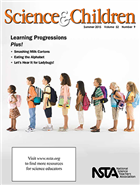 Science and Children: Learning Progressions Plus!
Science and Children: Learning Progressions Plus!
The NGSS provides information to support the development of learning progressions based on research. Students bring different backgrounds and skills to the classroom, so this issue intersects with the Science for All themes of other NSTA K-12 journals.
- Young children playing with clay is a familiar scene in pre-K schools (or it should be). The lesson in The Early Years: A Progression of Learning takes clay to a new level as students explore its properties, as well as learn to create. A similar type of progressing from parts and wholes to conservation of matter is described in Formative Assessment Probes: Snap Block.
- Eating the Alphabet describes an interdisciplinary kindergarten activity involving the sense of taste as students progress through the alphabet with familiar and unfamiliar foods (safety suggestions are provided).
- Dig Into Fossils! is a developmentally appropriate lesson for young children (K-2) in which they get hands-on experiences. For teacher background information, see Science 101: How Do You Date Fossils?
- Who knew that the ubiquitous milk carton could be the focus of an engineerng design project? The activities in Smashing Milk Cartons introduce students to the ideas of recycling and composting and to designing solutions to a school-wide, real-world problem. More engineering applications can be found in Engineering Encounters: You and Your Students as Green Engineers.
- STEM learning does not have to be limited to the classroom. Families Learning Together can be a powerful way to foster a progression of lifelong learning.
- Let’s Hear It for Ladybugs! as student learn about life cycles.
- The two lessons in Teaching Through Trade Books: All the Water in the World illustrate how lessons at the K-2 and 3-5 grade levels can focus on the topic at different levels of sophistication.
[For more on the content that provides a context for these projects and strategies see the SciLinks websites for Watersheds, Water Underground, Fossils, Recycling, Composting, Life Cycles, Metamorphosis, Insects]
 Add these journals to your summer reading!
Add these journals to your summer reading!
The Science Teacher: Big Data


